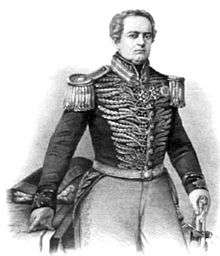Pampa (horse)
| Distinguishing features | Gaited and Pinto Coats |
|---|---|
| Country of origin | Brazil |
| Equus ferus caballus | |
The Pampa Horse is a horse breed that combines the conformational characteristics of Brazilian Horses that are gaited with a pinto spotting pattern of white and dark coat colors. Developed from a base of spotted horses of the Mangalarga Marchador, Campolina, Brazilian crossbred horses, and others. This breed is a very similar to a Spotted Saddle horse in US, but in the case of Pampa Breed are only accepted spotted horses.
History
As the Pampa is a spotted breed of Brazilian horses, their history begins with the introduction of this coat in Brazil, and there is no record of a precise date for the arrival of these types of horses.
However it is believed that the color pattern was introduced with the first horses brought by Spanish settlers to South America (such as the Andalusian horse and Jaca Navarra)[1] in the south of the South American continent (which is also where breeds such as the Criollo[1] and Campeiro[2] originated), as well as a few horses of Barb horse origin, brought by Portuguese settlers, and Dutch horses, brought to northeastern of Brazil with the Pernambuco invasion.[3]
Name Reason

The origin of the Pampa horse name and Tobiano coat color comes from the same man, the Brazilian Brigadier and horse breeder Rafael Tobias de Aguiar, that which created spotted horses, pinto horses, in the mid-19th century.
The Brigadier Rafael Tobias de Aguiar led the Liberal Revolution in Brazil along with Father Diogo Antônio Feijó to combat the rise of the Conservatives during the early reign of Dom Pedro II. With all he was defeated by the imperial forces in the Sorocaba province, and he fled with his army and troop of pinto horses to Rio Grande do Sul, to join the rebels of the Ragamuffin War. However, six months after having fled the Sorocaba province, Tobias was arrested in Palmeira das Missões and taken to the Laje Fortress, in Rio de Janeiro.[4]
Relationship of the Names: Pampa and Tobiano
- Pampa

However when these pinto horses of the soldiers that accompanied Brigadier returned to São Paulo, they became gradually known throughout the Brazil as the horses of the "Pampas",[3] the predominant biome of Rio Grande do Sul (occupying about 63% of the state territory), where Tobias fled.
- Tobiano
Tobias, in his passage through Rio Grande do Sul, presented some gaucho farmer of Cruz Alta with one of their spotted horses, and because of that and the fact that he passed through the towns and villages of the Rio Grande do Sul, with their spotted horses, the horses of this type, in this region, they were named by Tobia's Horses, which eventually evolve into Tobianos Horses, and this name was eventually spread throughout South America then to the North America
The interesting thing is that this flight was that gave reason to name, for different reasons, but with the same fact, the same Brigadier and his troops of horses, who cross São Paulo to Rio Grande do Sul with their tobiano horses and spread the "Pampa" name, because of the relationship of the origin of the horses with the Rio Grande do Sul biome, and "Tobiano" because of the name of Brigadier (Tobias).
Characteristics
Introducing with the color breed, the Pampa horse comes from crossbreeding between breeds including the Anglo-Arabian, Campeiro, Campolina, Criollo, Mangalarga, Mangalarga Marchador, Thoroughbred, and Brazilian crossbred horses. That's why pintos horses originating registry are accepted in this breeds.
The basic characteristics is an international morphology of a saddle horse, preserving the forms of progress. Not to deface the national Pampa morphology are vetoed the source animals records in animals that have a origin in Quarter Horse and Arabian, in other races considered exotic.[5]
See also
Footnotes
- 1 2 "Criollo Horse History". Brazilian Association of Criollo Horse Breeders = 2015-09-21.
- ↑ "Campeiro Horse History". Cavalo Campeiro. Retrieved 2015-09-21.
- 1 2 "Origin of Pampa by Lúcio Sérgio Andrade". ABCPAMPA. Retrieved 2015-09-21.
- ↑ "Brigadier Rafael Tobias de Aguiar". InfoEscola. Retrieved 2015-09-23.
- ↑ André Galvão Cintra (September 2013). "Raças de Cavalos criadas no Brasil / Horses breed raised in Brazil" (PDF) (in Portuguese). Animal Business Brasil da Sociedade Nacional de Agricultura.
.jpg)